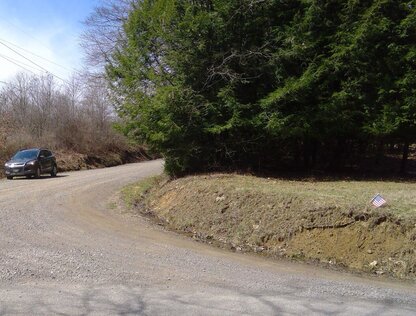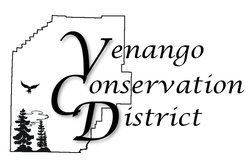Our Dirt, Gravel, & Low Volume Roads TechnicianThe Dirt Gravel and Low Volume Road (DGLVR) Resource Technician is responsible for the implementation and administration of the DGLVR Program by protecting the soil and water resources of Venango County. Specific duties include providing assistance to municipalities and other eligible entities with all aspects of program operations including application assistance, contract management, and other procedures, as well as participate in outreach programs that support program objectives. For questions or to request technical assistance, please contact: Lisette Lane District Manager (814) 676-2832 ext. 6 [email protected] |
Program HistoryPennsylvania has over 121,000 miles of roads. Of that total, over 25,000 are unpaved, predominately dirt and/or gravel. For many years, concern has increased regarding runoff generated from dirt and gravel roads. Several years ago, the Pennsylvania Council of Trout Unlimited began to voice collected concerns about sediment pollution originating from unpaved roads causing problems in the state's premier trout streams. From those concerns, a task force comprised of sportsmen and women, environmental resource agencies, local government representatives, private companies, citizen environmental groups, Penn State researchers, and legislative staff was assembled to further investigate those concerns. From that investigation, a locally-based, locally-controlled, cooperative approach to eliminate non-point source pollution occurring from rural roadways was recommended. Eventually, legislation was passed to provide money from the motor license fund, through conservation districts to municipalities to employ "environmentally sound" maintenance of dirt and gravel roads... to the tune of $4,000,000 a year!
The addition of funding for Low Volume Roads was realized by Act 89 of 2013. The act specifies that “A minimum of $8,000,000 of the total appropriated annually shall be for maintenance and improvement of (paved) low-volume roads.” A low volume road is “sealed or paved with an average daily traffic count of 500 vehicles or less.” A paved road is any road surfaced with asphalt, “tar and chip”, “chip seal”, bitumen, concrete, or other asphalt-like coating. |
How Does the Program Work?
Any state or local public entity that owns and maintains public roads is eligible to apply for Program funding. The majority of applicants are townships, but other entities such as boroughs, cities, counties, PA Game Commission, PennDOT, PA Fish and Boat Commission, and others are eligible to apply. The individual who is responsible for the project must attend a two-day Environmentally Sensitive Maintenance (ESM) training session hosted by the Center for Dirt and Gravel Road Studies prior to application for funding. Municipalities make applications to the conservation district (1 page), typically based upon specific site reviews and discussions with our district.
Projects are classified as either Dirt and Gravel Roads or Low-Volume Roads. Dirt and gravel road funding dollars are divided among Pennsylvania's 66 conservation districts based largely upon the total of unpaved road areas in each respective county. Miles of dirt and gravel roads, length of identified pollution sites (worksites), local cost of limestone, and miles of dirt and gravel roads in High Quality (HQ) and Exceptional Value (EV) watersheds are considered when making allocations to each county. From there, any township that maintains dirt and gravel roads (excluding paved or tar and chip) is eligible to apply for a road maintenance 'grant'. The focus for low volume roads maintenance utilizes the same practices as the Dirt & Gravel Roads funding, which is environmentally sensitive road maintenance practices that reduce the impact of road runoff and sediment to local streams, while reducing long term road maintenance costs. Stream Crossing Replacement projects can be completed on dirt & gravel and low-volume roads. The replacement of stream crossings has been a growing component of many DGLVR projects since program funding increased in 2014. The Program focuses funding on structures that are creating environmental impacts because they are undersized for the stream channel. Undersized structures create a variety of environmental and maintenance problems such as gravel deposition, excessive erosion, flooding, and creating a barrier to the movement of fish and other aquatic organisms. Annually, all applications are reviewed by the Quality Assurance Board (QAB), which is made up of a non-voting chairman appointed by the conservation district, a representative of the Natural Resources Conservation Service, a representative of the PA Fish and Boat Commission, and a representative appointed by the conservation district directors. Applications are ranked based upon a set of locally determined criteria, and funded based upon available funds. What Happens After a Grant is Awarded? The program is handled completely at the local level. Once a grant has been awarded, the municipality schedules and completes the improvements based upon the time frame and conditions agreed upon in the contract. The project management is exactly like any other road project the municipality performs. After the job is completed, the municipality is reimbursed for project expenses associated with the grant. What Expenses are Eligible for Reimbursement? The goal of the program is to control the amount of sediment leaving the roadway and entering streams. Since it is a cooperative approach, we try to balance grant funding across the county by maximizing the amount of in-kind donation from the municipality, typically by means of equipment and labor. Any materials necessary for achieving the goal of controlling sediment pollution such as a surface/subsurface drainage improvements, driving surface and ditch stabilization, vegetation management, or equipment related costs (that which the municipality cannot perform) are eligible expenses for reimbursement. |
Important FormsThe forms listed here are used for proposed and existing Dirt, Gravel, and Low Volume Road projects. Please contact our DGLVR resource technician for assistance with identifying proposed project sites, grant application procedures, required permits, and other pertinent details relating to the program.
Venango DGLVR Quality Assurance Board Policies & Procedures A list of policies and procedures that guide the program in Venango County. DGLVR Grant Application Forms Includes grant application, work plan, and expenditure sheets DGLVR Grant Application Forms Instructions Instructions to complete the above forms. DGLVR Project Completion Report Report used to summarize a completed project. DGLVR Project Completion Report Instructions Instructions to complete a project completion report. DGLVR Off Right-of-Way Consent Form Example consent form to obtain permission from a landowner to perform work and/or outlet water onto their property. DGLVR Traffic Count Validation Form Form for recording traffic counts to insure that paved Low Volume Roads have traffic counts of ≤500 vehicles per day in order to be eligible for funding. DGLVR Traffic Count Validation Form Instructions Instructions to complete the traffic count validation form. VCD Stream Crossing Notification Letter A letter template to be sent to the VCD DGLVR Quality Assurance Board (QAB) describing the proposed project. DGLVR List of Potentially Applicable Permits for Stream Crossing Projects List and links to permits that may be applicable for crossing replacement projects. DGLVR Stream Crossing Engineering Request for Proposal Request to receive proposals or bids to provide engineering services to the project. |
|
|
Awarded Dirt & Gravel Road Projects Fiscal Year 2023-2024 Canal Township, Wood Road - $95,877.00 Oakland Township, Gifford Road - $147,430.96 Pinegrove Township, Hale Road - $197,720.00 Irwin Township, Kerr Road - $80,000.00 Awarded Low-Volume Road Projects Fiscal Year 2023-2024 Irwin Township, Whieldon Road - $23,700.00 |
Environmentally-Sensitive Maintenance (ESM)
 Sediment from this gravel road is running with rainwater down the ditch, but where does the ditchwater empty? Often into a nearby stream which is just one of many causes of non-point source pollution. The district assesses these sites to identify where future ESM practices could be installed to reduce pollution entering the nearby stream from roads like this. Sediment from this gravel road is running with rainwater down the ditch, but where does the ditchwater empty? Often into a nearby stream which is just one of many causes of non-point source pollution. The district assesses these sites to identify where future ESM practices could be installed to reduce pollution entering the nearby stream from roads like this.
ESM is a term used to describe a suite of principles and practices that are designed to create a more environmentally and financially sustainable public road system. They are long term practices designed to reduce erosion and maintenance within the road area. Long-term environmental benefits are achieved by attempting to “restore natural drainage” to a state similar to how it was before the road existed. In contrast to traditional “stormwater systems” that are designed to collect and convey large volumes of runoff, ESM practices focus on diffusing flow at the source, encouraging infiltration and reducing concentrated flow volumes. Environmental benefits of this approach to waterways include reduced sediment and other pollutant delivery, and reduced flood flows by “disconnecting” the road drainage system. Long-term financial benefits are achieved because the same forces of erosion that cause environmental damage translate into increased maintenance costs as well. Every time a road, ditch, or bank washes out, it requires a large time and money investment by the local road owning entity. Some ESM practices may have higher than average up-front costs, but they save money over their lifetime by reducing future maintenance needs and costs.
In order to be eligible to apply for Program funds, the person in charge of work plan development and project implementation from the road-owning entity must have attended environmentally sensitive maintenance (ESM) training within the past five (5) calendar years. This training, and all past ESM trainings, counts as eligibility to apply for BOTH Dirt and Gravel and (paved) Low Volume Road funds for a period of five (5) calendar years. The Center for Dirt & Gravel Road Studies' Environmentally Sensitive Maintenance (ESM) Course is an intense two-day classroom session focused on providing the knowledge and tools necessary for road owners to maintain roads in a more cost-efficient and environmentally sensitive manner. The course runs from 8 am to 4 pm for two days and includes lunch. ESM Principles • Avoid concentrating drainage where possible • Minimize Flow Volumes • Reduce effects of concentrated drainage • Reduce surface erosion • Reduce cost and frequency of road maintenance |
ESM ResourcesUse these Environmentally Sensitive Maintenance (ESM) resources for course registration and project management.
ESM Course Registration Click here to register online for the next ESM course offered in your area. Eligibility List Click here to view the list of attendees who completed ESM training. Last updated: 11/28/2022 ESM Training Guide & Take-Home Reference Book The follow along training guide and take-home reference book provided at each training ESM Field Guide Field Guide for Environmentally Sensitive Maintenance of Unpaved Roads ESM Technical Bulletins Publications detailing specific ESM practices |


